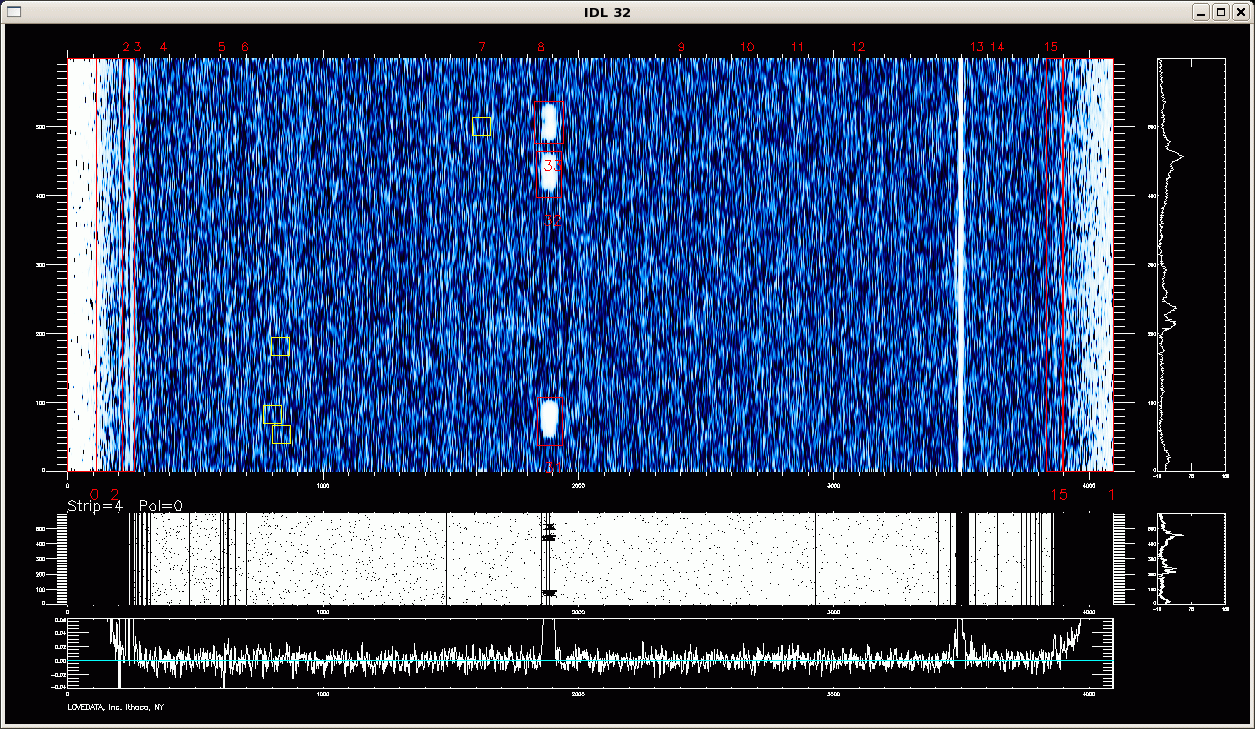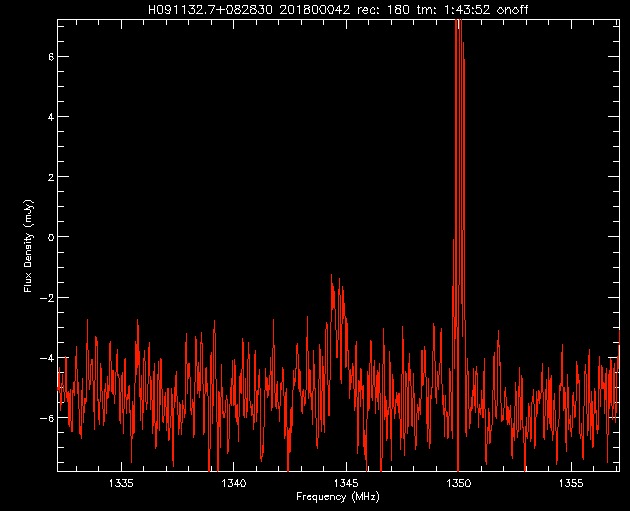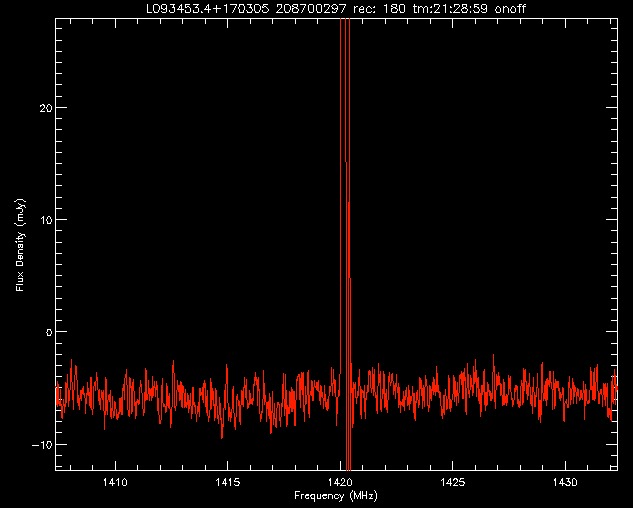UAT13.01 Scavenger Hunt #2: Introduction to LBW spectra and TOPCAT
This scavenger hunt will provide an introduction to the spectra we obtain from the L-band wide observations and also get you to use the TOPCAT, the Tool for OPerations on Catalogues And Tables.A2010 observers' favorite quote
-- Harlow Shapley, "Through Rugged Ways to the Stars"
2.0 Temperatures, temperatures, temperatures... Radio astronomers are always talking about temperatures. But, what are they talking about? a. What do we mean by "system temperature"?
b. What is the temperature in the LBW dewar?
c. How are the LBW amplifiers kept that cold? (i.e. what refrigerant is used)
d. What do 21 cm HI line astronomers mean when they talk about the "spin temperature"?
e. What is the "brightness temperature" of a radio source?
f. What is the "antenna temperature" of a radio source?
g. What do astronomers mean by the "system gain"?
h. What is the flux density (in Janskies) of the Sun at 1.4 GHz? How does that compare with the system temperature of LBW? (Hint: Think about how bright it would appear if we pointed LBW at it.)
i. What is the typical temperature and density of a diffuse HI cloud in the Milky Way?
j. What is the typical temperature and density of a molecular H2 cloud in the Milky Way?
k. What is the typical temperature and density of an ionized HII cloud in the Milky Way?
l. What is the temperature of the Cosmic Microwave Background radiation?
m. What is the temperature in Ithaca, NY right now?
n. How hot was it in the famous futuristic 1967 film starring Julie Christie and Oskar Werner?
2.1 ALFALFA followup: Why bother?... Now that we have completed the ALFALFA drift scan observations, we are conducting targeted observations of interesting ALFALFA detections or possible detections. We call this program "Harvesting ALFALFA". a. How long does it take a point source to drift across an ALFA beam? Hmmm... seems like we've thought about this one somewhere else..
b. We say that the "effective" integration time for ALFALFA is about 40 seconds per beam. How do we get the answer "40 seconds", i.e. what considerations apply?
c. The AGES program maps small areas (~10-20 square degrees each vs. 7000 for ALFALFA) using ALFA with an effective integration time of 300 seconds. For the same spectral resolution, how much more sensitive (lower rms) is AGES than ALFALFA? Hint: use simple scaling!
d. We might imagine that if we observe for a really long time, the noise in the spectrum would continue to decrease. In practice, this is not the case. Why not?
e. What rms noise (in mJy) will we expect our 3-minute ON-OFF observations to give us, at a velocity resolution of 10 km/s? How does that compare to ALFALFA?
f. The ALFALFA bandpass covers 1335-1435 MHz. What spectral line has a rest frequency of about 1424 MHz? If we wanted (deliberately) to observe emission from that line close to its rest frequency, where (in the sky) might we look?
g. Suppose we observe a source with a frequency that, if the line is HI, is -1515 km/s. Why don't we think this is an HI source? If it is an OH megamaser, what is its redshift?
2.2 The dreaded RFI: ugly GPS stuff!
| Here is FLAGBB display of one 10-minute drift scan observations from the main ALFALFA survey. The horizontal axis shows frequency and the vertical axis shows the successive 1-sec records. The blue scale reflects the intensity at each frequency pixel in the map, with white meaning higher flux. Three bright spots are flagged in the center of the frame. They arise from the Nuclear Detection (NUDET) system aboard the Global Positioning System (GPS) satellites. Refer to this figure in answering the following question. Click here for a larger view of the screen. a. What is the approximate frequency of the NUDET transmissions? b. What is the radial velocity of a galaxy whose HI line emission will be observed at that same frequency? c. How many GPS satellites are there? d. What is the orbital period of a GPS satellite? e. How could you find out how many GPS satellites there are above Puerto Rico now? You don't have to do this; just tell us how you would go about it. f. In the movie "Some Like It Hot", who (what actor) utters the famous closing words "Well, nobody's perfect."? |  |
2.3 Enigmatic ALFALFA sources Let's look at some of the spectra taken during last spring's LBW followup observations, under AO program A2669. You can click on each spectrum to view a larger version.

| |

| |

 Click here to see a zoomed in version of the 2nd one. | |

| |
| i. What actor delivered the line: "My Mama always said, 'Life was like a box of chocolates; you never know what you're gonna get.'"? |
2.4 Introduction to TOPCAT: the Tool for OPerations on Catalogues And Tables, an interactive java graphical program which has been developed by astronomers at the Virtual Astronomical Observatory.
- TOPCAT home: http://www.star.bristol.ac.uk/~mbt/topcat/
- TOPCAT manual: http://www.star.bristol.ac.uk/~mbt/topcat/sun253/index.html
- TOPCAT tutorial: http://andromeda.star.bris.ac.uk/topcat/tutorial/
h. Why are the points distributed so that they spread out in the vertical direction at nearer distances but are more confined in log Msun as the distance increases?
g. There appears to be a gap in the distribution near the right at a distance of about 220 Mpc. What causes that gap?
h. There is a less obvious gap at a distance of about 80 Mpc. What causes that gap? i. There appears to be a vertical line of points at a distance of about 17 Mpc. What causes the apparent line?
There are lots of other things you can do with TOPCAT. We encourage you to learn how to exploit its capability!
2.5 (Important) questions about the Arecibo staff a. Which Arecibo staff member spent 8 years with the Klamath Indians in Oregon (rustling cattle, so the rumor goes) before moving to Puerto Rico?
b. Who is perfecting a new drink called the "avocalada"?
c. What was the traditional sumptuous delicacy made by Martha and savored by Willy during late night observing runs over the Christmas and New Year's holidays?
d. Who played Carl Sagan wandering around the observatory during the filming of the Cosmos series, when Carl did not make the trip to Arecibo?
Last updated Mon Jan 13 21:31:43 AST 2013 by martha
